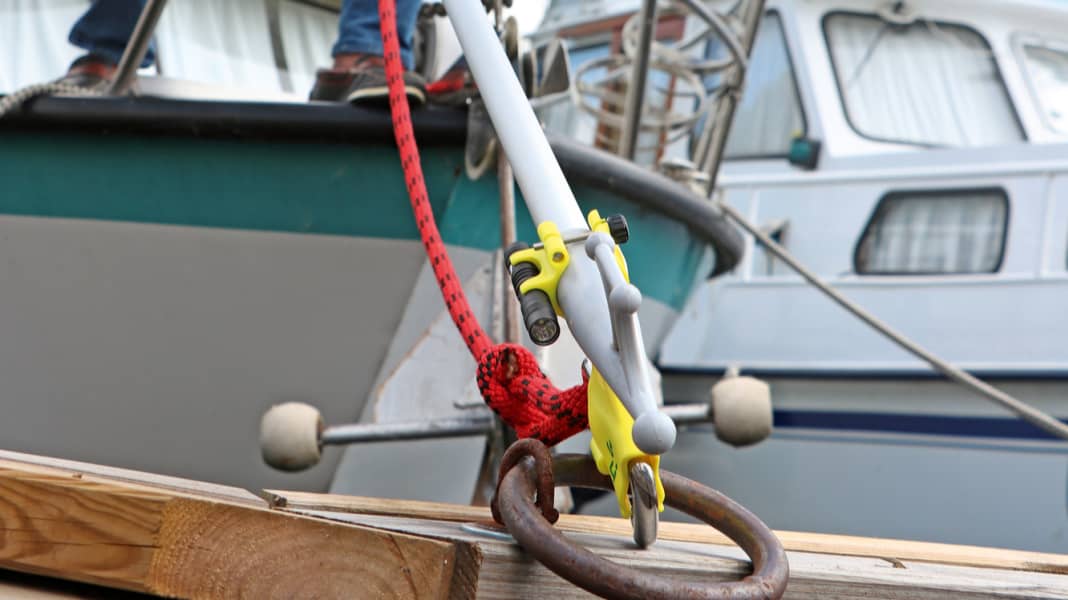
Special boat hooks or their attachments enable a quick line connection so that the mooring line can be loaded directly from the boat. This can be particularly helpful when Mooring at mooring buoys be. Three systems are available:
- The line threader guides the mooring line or a pilot line through the stay ring or cleat.
- The carabiner, which can be easily released when discarded and is immediately ready for use again.
- The line clamp holds a line eye spread in the boat hook so that it only needs to be placed over the cleat.
The price range and quality of the products vary greatly: from the simple line clamp for around 13 euros, which is attached to the boat hook with cable ties, to the luxurious "Hook & Moor" with carbon fibre reinforcement and ball bearings for around 250 euros. We are excited, but remain sceptical. Only a practical test can show whether these innovations are really useful or just convincing on paper.
Boatasy Hooklinker
approx. 55 Euro >> available here
The Boatasy Hooklinker has a holder made of yellow hard plastic that is clamped around a boat hook using screws. The bracket fitted well on our test boat hook with a tube diameter of 30 millimetres, but it is flexible enough to adapt to weaker tubes. The scope of delivery is surprising, because for a manageable purchase price (approx. 55 euros) it even comes with a torch so that you can find the mooring ring even at night. The carabiner sits tightly in its holder, so there is no risk of it falling out on first contact. With its opening width of 45 mm, it can be easily attached to any ring, but reaches its limits with larger jetty cleats. Depending on the intended use, the carabiner can also be replaced with the GHook line pulley, which can be clipped into tensioned guide lines between the stern post and the jetty.
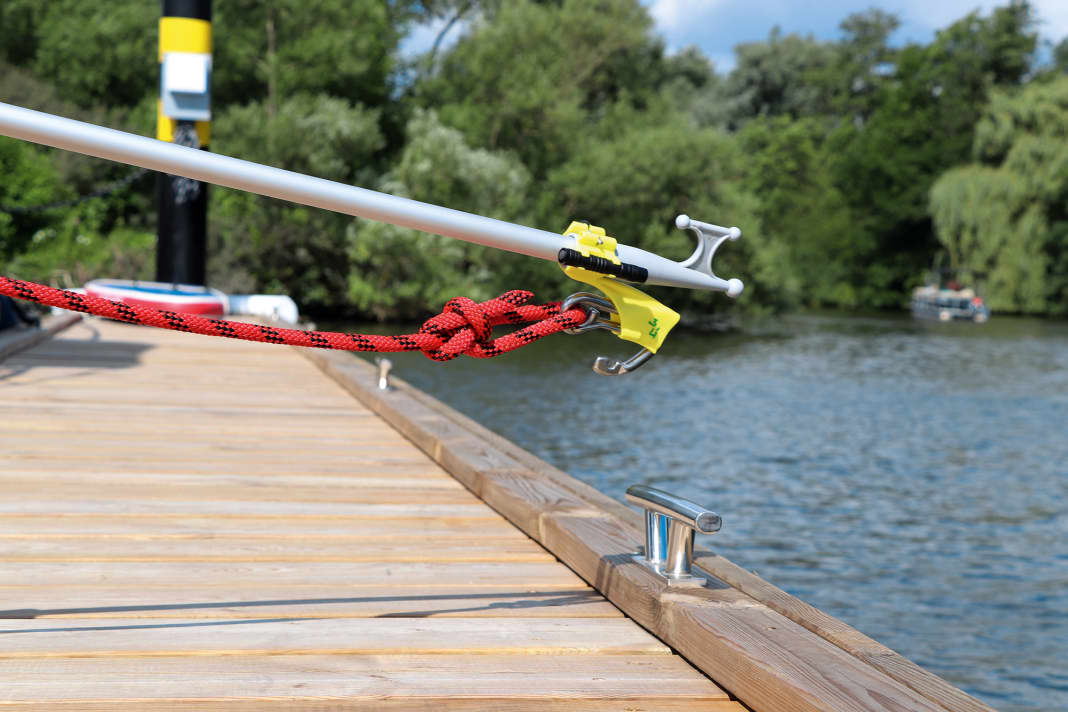





Kong.it/Type 201
approx. 63 Euro
The type 201 mooring hook from Kong (approx. 63 euros) from Italy is not light due to its large dimensions (550 grams), but with an opening width of 55 mm, it can also be hooked behind thicker cleats. It is very sturdily made and (according to the manufacturer) can withstand a tensile load of 2.4 kN. In addition, this model does not require a retaining fitting on the boat hook side - the boat hook is simply inserted into the outer eye of the stainless steel shackle. Pulling on the mooring line (up to 23 mm thick) holds the hook on the boat hook and opens the catch at the same time. If the hook is placed over the shore-side attachment, it closes automatically when the boat hook is pulled back.
A good concept. The only drawback is that the catch always hangs half open when the retaining ring is above the boat. Gravity then pulls the release bar downwards and the gate opens. A clear advantage of this tensioning technique is that the carabiner can be quickly made ready for use again after a failed attempt. The other two boat hooks with carabiners have to be retrieved and reattached. Instead, the boat hook is simply reinserted into the eye of the bail and tensioned by pulling on the line. With a little practice, it is also possible to release the carabiner in this way without having to leave the boat.
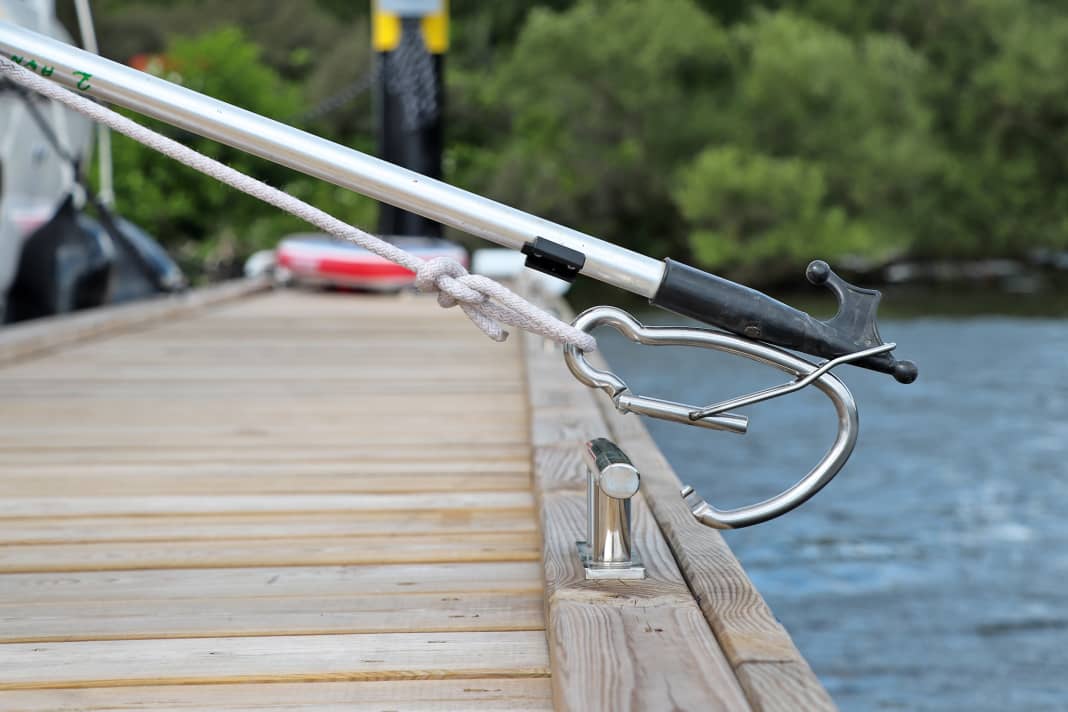





Kong.it/Type 16
approx. 46 Euro
Also from Kong is the type 16 model (approx. 46 euros), which is significantly smaller but also sturdily made. However, this is an ordinary carabiner that has two milled grooves on the snap bar so that it can be pushed into the retaining fitting when open, which is attached to the boat hook with self-tapping screws. Despite the slightly smaller dimensions (160 instead of 200 mm), the carabiner has an opening width of 30 mm. As the hook is only fixed in its rail by the spring of the carabiner, it can slip out more quickly when "poking" for the ring.
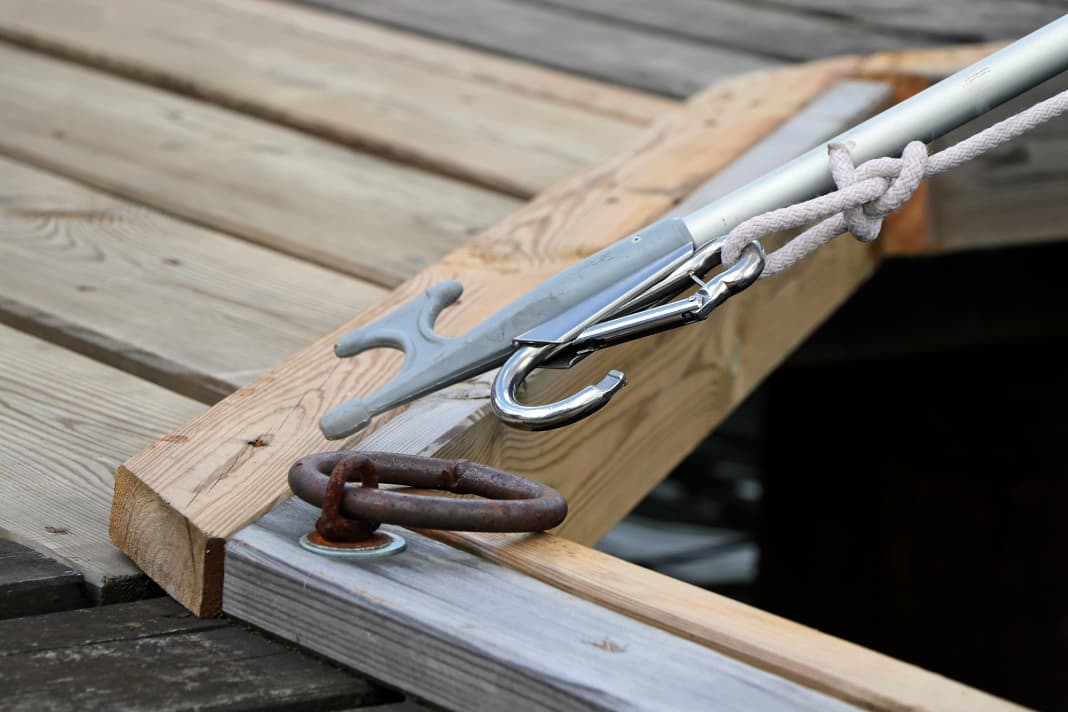





Osculati
approx. 40 Euro
Although a carabiner can be attached quickly, it must always be unhooked from the dock when casting off. A line threader is the more practical option for those who prefer a line that can be quickly cast off while lying on a slip. We have tried out three such systems.
The first model from Osculati (approx. 40 euros) is supplied with an extendable (1.05 to 2.45 m) aluminium tube. The attachment is made of durable special polymer and makes a light, stable impression. With an opening width of 52 mm, lines can also be threaded around very wide cleats. The deep sickle makes it necessary to pierce rings from below and then turn the ring. After hooking in, the red clip closes and locks into place by pulling up the hook on the opposite holder. When pulling back, the attached line is threaded around the ring or cleat.
A system that works perfectly. The only drawback is that the opening for the line is so small that only thin lines like the one supplied fit in. It is passed around the cleat as a pilot line, and only then can the correct mooring line be attached to it and tracked. However, this cannot be too thick, as otherwise the sheet line would be too thick to pass through the eye of a cleat - which would then require a jump onto the jetty, which you want to avoid.
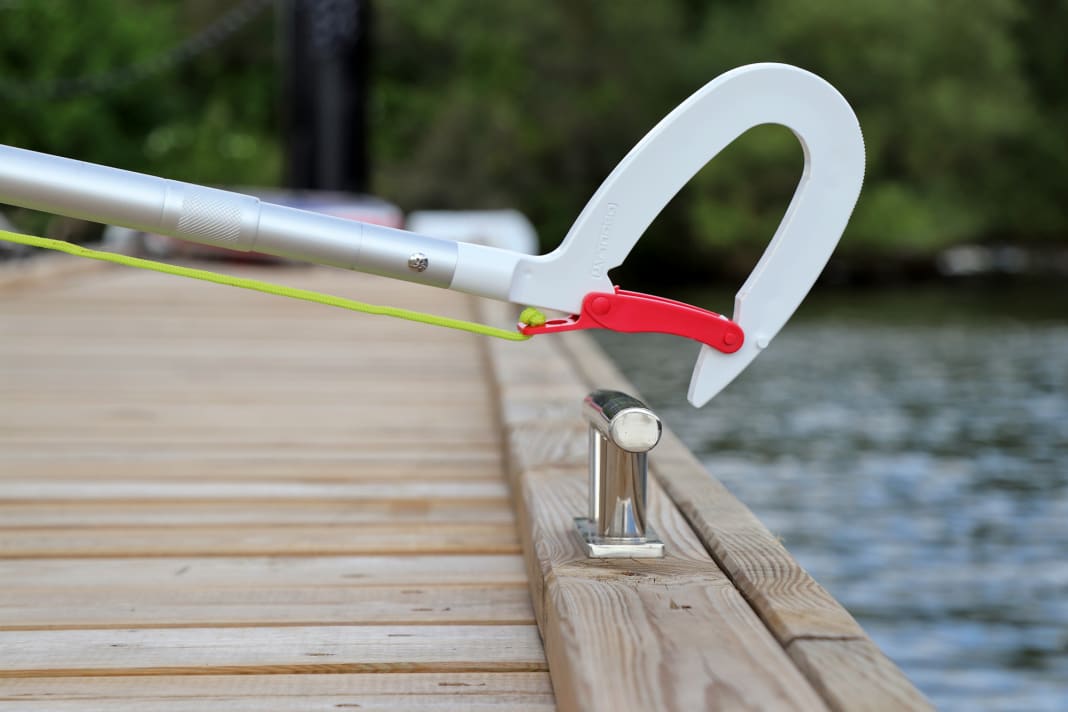





Jolly Hooker
approx. 13 Euro
The "Jolly Hooker" is a very reasonably priced alternative (approx. 13 euros), which makes a rather fragile impression with a body made of black cast plastic, but proves to be extremely stable in practice. With a solid screw fastening, it fits on any boat hook and has an opening width of 70 mm. The 1.90 metre long line supplied is intended as a pilot line - but the eyelet is large enough to allow thick mooring lines to be inserted directly.






Hook & Moor
approx. 150 Euro >> available here*
The "Mercedes" among the line threaders is the tried and tested hook-and-moor hook, which has a carbon fibre-reinforced head and is mounted on an adjustable (1.00 to 1.80 m), oval aluminium tube. Although the price is significantly higher at around 150 euros, the hook is also in a completely different league in terms of manufacturing quality and complexity of development. Every detail appears stable, well thought-out and of high quality. With an opening width of 45 mm and a ring-like shape compared to its sickle-shaped competitors, the hook is deep enough to loop around all common cleats. The threading mechanism runs on ball bearings. A special stainless steel shackle holds the mooring line, which should ideally have a spliced-in eye, as knots can hinder threading.
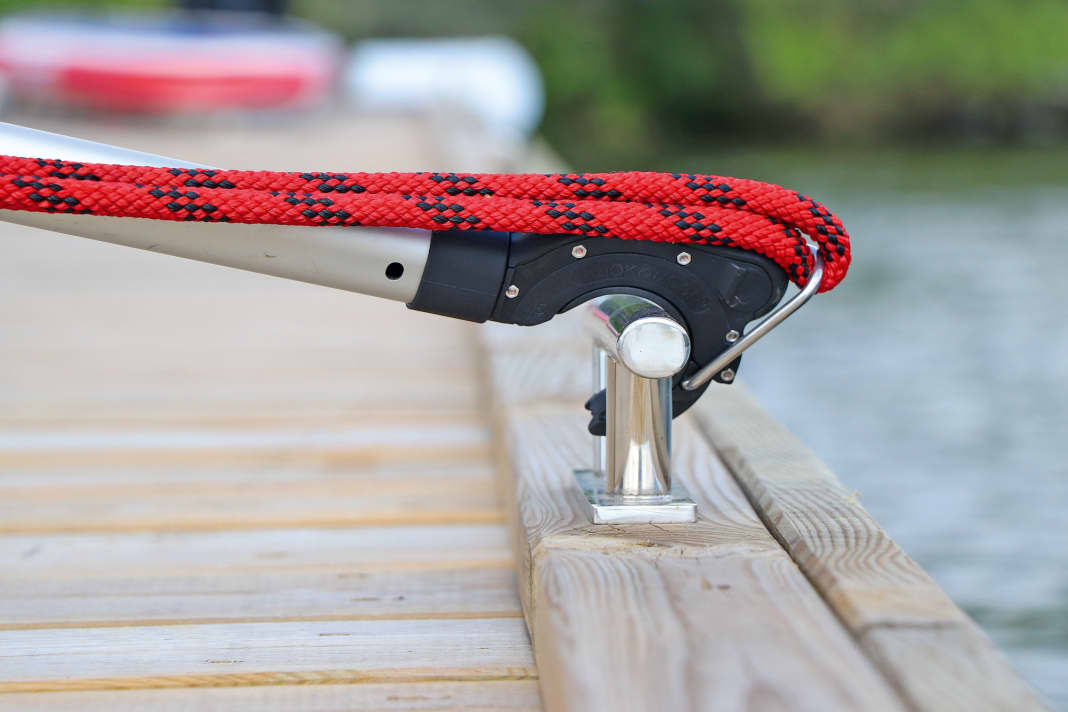





Sailmatic
approx. 17 Euro
The last model from Sailmatic does not help when threading through a line, but it does help when attaching it to a cleat or bollard. It is not only inexpensive (approx. 17 euros), but also very simple: made entirely of rubber, it can be slid onto a boat hook and fastened with two cable ties. A mooring line with a spliced-in eye or bowline is placed over the tip of the boat hook and the lower part of the eye is pulled into the rubber clamp. In this way, the clamp holds the eye open, which only needs to be placed over an attachment point on the jetty.






Conclusion
Whichever aid the skipper chooses - all models proved to be functional and stable enough in the test, but some solutions may be more suitable for a particular berth than others. The most popular in the test were the boat hooks from Hook & Moor and the line clamp from Sailmatic. One model because it is particularly well thought out - the other because it is as simple as it is ingenious.

